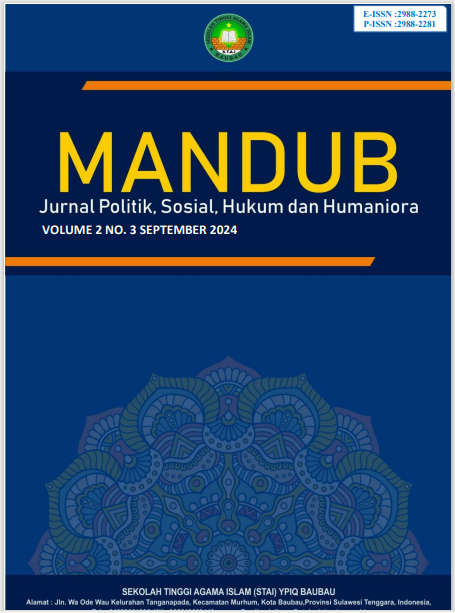Identifikasi Kearifan Lokal Masyarakat Adat Kayu Batu, Kayo Pulau, dan Skouw Yambe dalam Pengelolaan Lingkungan
DOI:
https://doi.org/10.59059/mandub.v3i1.2729Keywords:
Environmental preservation, Indigenous communities, Local wisdomAbstract
Organisms and their natural environments are inherently connected and interdependent, with humans relying extensively on natural resources to meet daily needs and sustain life. Among them, indigenous communities maintain a distinctive relationship with their surroundings, guided by traditional ecological knowledge passed down orally from generation to generation. This body of knowledge, known as local wisdom, is deeply embedded within the natural, social, and cultural contexts of each community and plays a vital role in ensuring their long-term survival and well-being. The present study aims to examine the current socio-cultural conditions of customary law communities in three indigenous villages of Jayapura City—Kayu Batu, Kayo Pulau, and Skouw Yambe. Specifically, it seeks to identify the types of local wisdom practiced within these communities and to assess the efforts undertaken to preserve such traditions. A qualitative research approach was adopted, employing multiple data collection techniques, including direct observation, in-depth interviews with community leaders and members, and literature review of related studies and historical accounts. The findings indicate that, despite increasing pressures from modernization, urban expansion, and external cultural influences, these communities continue to implement local wisdom in managing and protecting their natural environment and resources. This includes sustainable harvesting practices, customary rules for resource allocation, seasonal restrictions to allow ecosystem regeneration, and culturally embedded conservation rituals. The endurance of these practices is supported by the functioning of customary institutions, strong kinship ties, community protocols, and collective decision-making mechanisms that integrate environmental considerations. In conclusion, the study demonstrates that the environmental stewardship, resource management practices, and cultural identity of these three customary communities remain actively upheld. This resilience underscores the critical importance of safeguarding indigenous knowledge systems as a foundation for environmental sustainability and cultural preservation in the face of contemporary socio-economic change.
References
Badan Pusat Statistik Kota Jayapura. (2022). Kota Jayapura dalam angka 2022. https://doi.org/1102001.9471
Haris, M., & Tim Penulis. (1999). A. Kebudayaan (Bab II).
Haryanto, J. T. (2014). Kearifan lokal sebagai basis pembangunan berkelanjutan. Jurnal Penelitian Humaniora, 19(1), 1–12.
Kementerian Lingkungan Hidup dan Kehutanan Republik Indonesia. (2017). Peraturan Menteri Lingkungan Hidup dan Kehutanan Republik Indonesia Nomor P.34/Menlhk/Setjen/Kum.1/5/2017 tentang pengakuan dan perlindungan kearifan lokal dalam pengelolaan sumber daya alam dan lingkungan hidup.
Koentjaraningrat. (1974). Beberapa pokok antropologi sosial. Dian Rakyat.
Koentjaraningrat. (1980). Sejarah teori antropologi.
Koentjaraningrat. (1990). Beberapa pokok antropologi sosial (Cetakan ke-7). Dian Rakyat.
Rahim, S. (2013). Kearifan lokal dalam pengelolaan sumber daya alam. Jurnal Bumi Lestari, 13(2), 205–214.
Salim, E. (2010). Lingkungan hidup dan pembangunan berkelanjutan. Jakarta: Pustaka LP3ES Indonesia.
Sartini. (2004). Menggali kearifan lokal Nusantara: Sebuah kajian filsafat. Jurnal Filsafat, 37(2), 111–120. https://doi.org/10.22146/jf.3136
Seligman, B. Z., & Royal Anthropological Institute of Great Britain and Ireland. (1951). Notes and queries on anthropology. Routledge and Kegan Paul.
Soekamto. (1999). A. Kebudayaan (Bab II).
Tylor, E. B. (1871). Primitive culture: Researches into the development of mythology, philosophy, religion, art, and custom.
Undang-Undang Republik Indonesia Nomor 32 Tahun 2009 tentang Perlindungan dan Pengelolaan Lingkungan Hidup, Pub. L. No. 32 (2009).
Widjono, A. (2012). Kearifan lokal dan pelestarian lingkungan. Jakarta: LIPI Press.
Downloads
Published
How to Cite
Issue
Section
License
Copyright (c) 2025 Mandub : Jurnal Politik, Sosial, Hukum dan Humaniora

This work is licensed under a Creative Commons Attribution-ShareAlike 4.0 International License.








